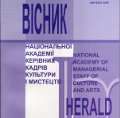ЕФЕКТИ КАМЕРНОГО СПІВУ У ТВОРАХ К. ОРФА (НА ПРИКЛАДІ СЦЕНІЧНИХ КАНТАТ CARMINA BURANA, CATULLI CARMINA, ОПЕРИ «РОЗУМНИЦЯ»)
Effects of Chamber Singing in Works by K. Orff (Case Study of «Carmina Burana», «Catulli Carmina» Scenic Cantatas, «Kluge» Opera)
Author(s): Larysa GorelikSubject(s): Theatre, Dance, Performing Arts, Sociology of the arts, business, education, Sociology of Art, History of Art
Published by: Національна академія керівних кадрів культури і мистецтв
Keywords: chamber singing; musical piece; scenic cantata; opera; vocal;
Summary/Abstract: The purpose of the article is to highlight the specifics of chamber singing as a special expressive technique in canvases, generally designed for presentation on a large scene, which allows, on the one hand, to clarify the idea of K. Orff's stylistics, and on the other hand, to make a contribution to the theory of chamber art in the aspect of modeling its features in the conditions of a large-scale scenic embodiment. The methodological basis of the research is the intonation approach to the nature of music in the traditions of the works of the followers of B. Asaf'ev's concept in Ukraine in the works of O. Markova, O. Muravska, L. Shevchenko with a principle emphasis on stylistic-comparative, hermeneutic, historical-descriptive, and cultural- disciplinary for secretion of epoch stylistic status of works, essential in modernity significance of their expressive aspects, their explanation by the author, historic world-outlook interaction of music expedients with expedients of other types of arts. The scientific novelty of the study is formed by the originality of the vision of the data expressiveness in the title of K. Orff's works, as well as the discovery of the theoretical formulation of such a feature of chamber vocals as «hiding» the dynamic excess of expressing the capabilities of the operatic voice by placing the melody in extreme registers with appropriate textural indicators. Conclusions. Chamber vocal constitutes a typological expressiveness of singing, which is organically adjusted by the conditions of salon or salon-style voicing of works, but also has a symbolic expressive cut, which, as a special method of sound expression, is detected in works designed for dynamic large-scale presentation, but with artistically grounded techniques of chamber singing in zones of so-called "quiet" climaxes and starting points of "crescendoing" dramaturgy, as we find in two famous scenic cantatas and the extremely popular opera by K. Orff.
Journal: Вісник Національної академії керівних кадрів культури і мистецтв
- Issue Year: 2023
- Issue No: 1
- Page Range: 235-240
- Page Count: 6
- Language: Ukrainian

